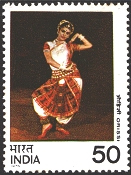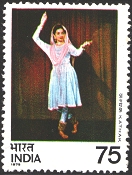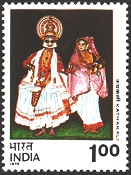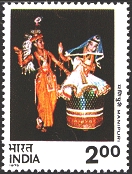India Honors the
Classical Dances of the Nation
by
Daniel Keren
SPREAD throughout a territory of
approximately 1,200,000 square miles, with a population that is rapidly
approaching the 700 million mark, the giant land of India dominates the entire
Asian subcontinent and is home to a wide assortment of ethnic groups. Together,
they form a most unique national entity. Over 1500 distinct languages and
dialects are spoken by the diverse groups that have, since the abolishment of
British colonial rule in 1947, combined to develop this ancient land into one of
the major emerging global superpowers.
Classical Dances
As in all nations blessed with a
rich and ongoing creative culture, India has, over a period of many millennium,
developed a rather advanced Style of classical dance. The art form has been
refined to an exquisite level and as such continues to both educate and
entertain. These classical dances play a major role in the social and cultural
awareness of today's Indian populace. For many tourists, these dances allow a
rare insight in the unique traditions that have enabled the Indian people-to
overcome recent centuries of colonial interference.
Regional Dance
Variations
Dr. Kapila Vatsyayan has, 'In
essay on Indian dance, explained that most of today's classical dances have
their roots in the early civilizations of both the Mohenjodaro and the Harappa,
cultures which arose from within the Indus Valley around the year 3,000 B.C. The
many regions that comprise the Indian nation have, because of their previous
isolation, managed to create interesting variations in certain basic dance
forms. That we know such dance styles of today are indeed derived from the
original creations of a few thousand years ago, is supported by what Mrs.
Vatsyayan terms as literary and sculptural evidence. From the -basic work, the
"Natyasastra", is found textual descriptions of the six dances that
form the basic classical dances of India today. Of course, in recent centuries,
the individual dances have gone through some noted revisions. But the basic
style can still be traced to the early creations of the Mohenjodaro and Harappa
civilizations.
To focus attention on their
valuable cultural heritage, the India Post Office released a series of six
stamps on October 20, 1975. Designed and printed by the staff of India Security
Press, this issue has become one of the most popular Indian issues of recent
times.
|

Bharat Natyam |

Orissi |

Kathak |
|

Kathakali |

Kuchipudi |

Manipuri |
กก
Developed in South India, the
"Bharata Natyam", which in its current style was formed some two
centuries ago, is featured on the 25 paise stamp. It is a basic component of the
traditional drama-dance form titled "Bhagvata Mela". For the most
part, the Bharata Natyam" is a solo dance which is noted for Combining such
dance techniques as straight lines, diagonals and triangle.
Another style somewhat similar
to the "Bharata Natyam" is the "Orissi", which is depicted
most elegantly on the 50 paise value. Dance scholars believe that the current
form was influenced from the sangita-nataka, a type of musical play, and the
akharas. The akharas were special gymnasiums in which special dances were
conducted. Remains of 2,000-year-old sculptures (2nd century B.C.) have been
uncovered that testify to the early origins of the Orissi dance form. Written
records of the "Orissi" are to be found in abundance from around the
12th century of the common era.
Turning to the north, one comes
across. the Kathak dance (75 paise). Richly communicating a sense of the
sophisticated urban dance culture, it displays qualities of intricate
craftsmanship and artistic virtuosity. The dance was very popular in the court
of the Nawabs. The Kathak style of today is a merging of different dance
methods, including techniques applied in the dance-dramas of the Mathura and
Brindavan temples, along with the more sophisticated style of the Nawab court.
The popular art form of
dance-drama is best epitomized by the "Kathakali". This classical
dance utilizes epic mythological subjects for its theme has the capacity to
transmit a sense of otherworldliness to its viewers. The productions of the
"Kathakali" are somewhat gaudy, with over-sized costumes employed to
present the image of enlarged human proportions and masks that communicate
complex symbolism which involve color; line and design.
The fifth dance depicted on the
Indian issue features the "Kuchipudi", which is very similar to the
"Bharata Natyam". This narrative dance is most popular in the Andhra
Pradesh region. The basic difference in this classical dance mode from that of
the "Bharata Natyam" is that the "Kuchipudi" enjoys a style
that is recognizably freer and less severe.
The final classical dance of India
that is featured on the 1975 issue is that of the "Manipuri". A
popular lyrical dance, the "Manipuri" was developed in Eastern India.
The current dance mode was fashioned in the aftermath Of the rise of the
Vaishnava cult. It includes a number of rather sophisticated dance forms which
were incorporated from the different religious and ritual dances that were
popular within the region from times past.
Credits, Acknowledgements and Disclaimer:
-
Article written by Mr. Daniel Keren. I take
no credit for it except for the fact that it was formatted by the webmaster
for web-publishing.
-
This article most likely appeared in "The American
Philatelist" in the 70's.
-
All colour images have been inserted by the web
master.
-
All copyrights acknowledged.
-
Article appears only as a reference source.
Please contact me if anybody has
a problem and I will reconsider the decision to put it up on the web-site.
Back to Main page
[email protected]





